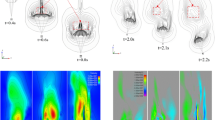Abstract
A numerical simulation method for parachute Fluid-Structure Interaction (FSI) problem using Semi-Implicit Method for Pressure-Linked Equations (SIMPLE) algorithm is proposed. This method could be used in both coupling computation of parachute FSI and flow field analysis. Both flat circular parachute and conical parachute are modeled and simulated by this new method. Flow field characteristics at various angles of attack are further simulated for the conical parachute model. Comparison with the space-time FSI technique shows that this method also provides similar and reasonable results.
Similar content being viewed by others
Abbreviations
- α :
-
angle of attack
- ρ :
-
air density
- V :
-
velocity
- V ∞ :
-
velocity at the inflow boundary
- Γ ϕ :
-
generalized diffusion coefficient
- S ϕ :
-
generalized source term
- p :
-
static pressure
- p ∞ :
-
pressure at the inflow boundary
- µ:
-
molecular viscosity coefficient
- µ e :
-
equivalent viscosity coefficient
- C p :
-
pressure coefficient
- ΔC p :
-
the pressure coefficient difference between the inner and outer canopy
- K :
-
turbulent fluctuation kinetic energy
- ɛ :
-
turbulent energy dissipation rate
- Re :
-
Reynolds number
- φ :
-
an angle between the canopy axis and the normal line of meridian
- ψ :
-
apex angle of conical parachute
- ω :
-
the half angle between two contiguous planes E
- ν, β, θ :
-
angles (see Figure 5)
- R f *:
-
dimensionless length of apex point of the cord line to the point on itself in unstretched gore state
- σ * m , σ * u :
-
dimensionless stress in canopy fabric in the longitudinal and latitudinal direction
- k :
-
shrink factor of canopy material
- r*:
-
dimensionless bulge radius of the canopy
- T*:
-
dimensionless force in cord line
- x * f , z * f :
-
dimensionless x and z coordinates of cord line in cylindrical coordinates
- E b , E f :
-
dimensionless elasticity modulus of canopy fabric and cord line
References
Tezduyar T E. Stabilized finite element formulations for incompressible flow computations. Adv Appl Mech, 1992, 28: 1–44
Tezduyar T E, Behr M, Liou J. A new strategy for finite element computations involving moving boundaries and interfaces—The Deforming-Spatial-Domain/Space-Time Procedure: I. The concept and the preliminary numerical tests. Computer Meth Appl Mech Eng, 1992, 94: 339–351
Tezduyar T E, Behr M, Mittal S, et al. A new strategy for finite element computations involving moving boundaries and interfaces—The Deforming-Spatial-Domain/Space-Time Procedure: II. Computation of free-surface flows, two-liquid flows, and flows with drifting cylinders. Comput Meth Appl Mech Eng, 1992, 94: 353–371
Mittal S, Tezduyar T E. A finite element study of incompressible flows past oscillating cylinders and airfoils. Int J Num Meth Fluids, 1992, 15: 1073–1118
Mittal S, Tezduyar T E. Parallel finite element simulation of 3D incompressible flows-fluid-structure interactions. Int J Num Meth Fluids, 1995, 21: 933–953
Stein K, Benney R, Kalro V, et al. Parallel computation of parachute fluid-structure interactions. Proceedings of the 14th AIAA Aerodynamic Decelerator Technology Conference, San Francisco, AIAA-97-1505, 1997
Kalro V, Tezduyar T E. A parallel 3D computational method for fluid-structure interactions in parachute systems. Comput Meth Appl Mech Eng, 2000, 190: 321–332
Stein K, Benney R, Kalro V, et al. Parachute fluid-structure interactions: 3D computation. Comput Meth Appl Mech Eng, 2000, 190: 373–386
Tezduyar T E, Sathe S, Keedy R, et al. Space-Time Finite Element Techniques for computation of fluid-structure interactions. Comput Meth Appl Mech Eng, 2006, 195: 2002–2027
Tezduyar T E, Sathe S. Modeling of fluid-structure interactions with the Space-Time Finite Elements: solution techniques. Int J Num Meth Fluids, 2007, 54: 855–900
Tezduyar T E, Sathe S, Pausewang J, et al. Air-fabric interaction modeling with the stabilized space-time FSI technique. Proceedings of the Third Asian-Pacific Congress on Computational Mechanics, Kyoto, CD-ROM, 2007
Tezduyar T E, Sathe S, Pausewang J, et al. Interface projection techniques for fluid-structure interaction modeling with moving-mesh methods. Comput Mech, published online, 2008, doi: 10.1007/s00466-008-0261-7
Tezduyar T E, Sathe S, Pausewang J, et al. Fluid-structure Interaction Modeling of Ringsail Parachutes. Comput Mech, published online, 2008, doi: 10.1007/s00466-008-0260-8
Kim Y, Peskin C S. 3-D parachute simulation by the immersed boundary method. Comput Fluids, 2009, 38: 1080–1090
Karagiozis K, Kamakoti R, Cirak F, et al. A computational study of supersonic disk-gap-band parachutes using Large-Eddy Simulation coupled to a structural membrane. J Fluids Struct, 2011, 27: 175–192
Patankar S V. Numerical Heat Transfer and Fluid Flow. New York: Hemisphere Publishing, McGraw-Hill, 1980
Zhu L C. An approximate approach to calculate drag, stress and deformation of inflated flat circular parachute (in Chinese). Land Technol, 1983, (1): 143–177, translated from the paper titled as Angenäherter Berechnung der Kräfte, Spannungen und Form des Ebenen Rundkappen-Fallschirms im gefüllten Zustand. DLR(FB) 71–98 Q (W) 0860
Suryanaranyana G K, Prabhu, A. Effect of natural ventilation on the boundary separation and near-wake vortex shedding characteristics of a sphere. Exp Fluids, 2000, 29: 582–591
Tobak M, Peake D J. Topology of three-dimensional separated flows. Ann Rev Fluid Mech, 1982, 14: 61–85
Sahu J, Cooper G, Benney R. 3-D parachute descent analysis using coupled CFD and structural codes. AIAA-95-1580, 1995
Coutanceau M. On the role of high order separation on the onset of the secondary instability of the circular cylinder wake boundary. C R Acad Sci Serie II, 1988, 306: 1259–1263
Bouard R, Coutanceau M. The early stage of development of the wake behind an impulsively started cylinder for 40<Re<104. J Fluid Mech, 1980, 101: 583–607
Author information
Authors and Affiliations
Corresponding author
Rights and permissions
About this article
Cite this article
Cao, Y., Wan, K., Song, Q. et al. Numerical simulation of parachute Fluid-Structure Interaction in terminal descent. Sci. China Technol. Sci. 55, 3131–3141 (2012). https://doi.org/10.1007/s11431-012-4998-z
Received:
Accepted:
Published:
Issue Date:
DOI: https://doi.org/10.1007/s11431-012-4998-z




